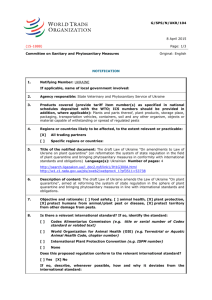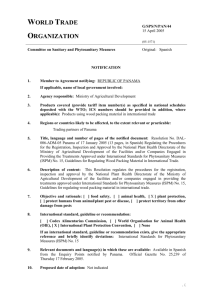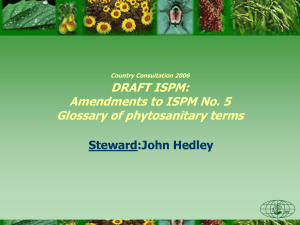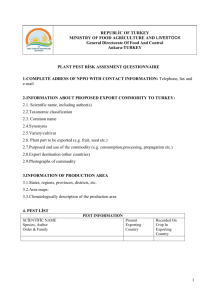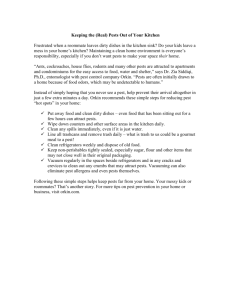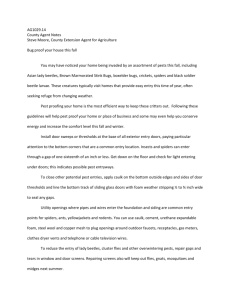phytosanitary regulations - World Agroforestry Centre
advertisement
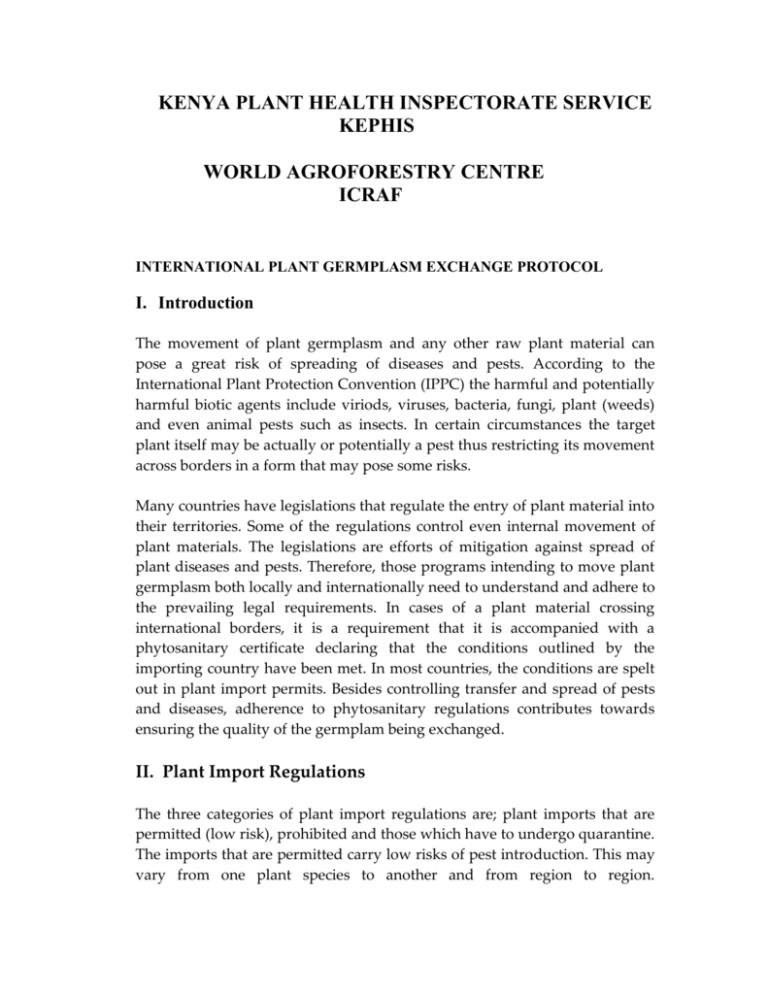
KENYA PLANT HEALTH INSPECTORATE SERVICE KEPHIS WORLD AGROFORESTRY CENTRE ICRAF INTERNATIONAL PLANT GERMPLASM EXCHANGE PROTOCOL I. Introduction The movement of plant germplasm and any other raw plant material can pose a great risk of spreading of diseases and pests. According to the International Plant Protection Convention (IPPC) the harmful and potentially harmful biotic agents include viriods, viruses, bacteria, fungi, plant (weeds) and even animal pests such as insects. In certain circumstances the target plant itself may be actually or potentially a pest thus restricting its movement across borders in a form that may pose some risks. Many countries have legislations that regulate the entry of plant material into their territories. Some of the regulations control even internal movement of plant materials. The legislations are efforts of mitigation against spread of plant diseases and pests. Therefore, those programs intending to move plant germplasm both locally and internationally need to understand and adhere to the prevailing legal requirements. In cases of a plant material crossing international borders, it is a requirement that it is accompanied with a phytosanitary certificate declaring that the conditions outlined by the importing country have been met. In most countries, the conditions are spelt out in plant import permits. Besides controlling transfer and spread of pests and diseases, adherence to phytosanitary regulations contributes towards ensuring the quality of the germplam being exchanged. II. Plant Import Regulations The three categories of plant import regulations are; plant imports that are permitted (low risk), prohibited and those which have to undergo quarantine. The imports that are permitted carry low risks of pest introduction. This may vary from one plant species to another and from region to region. Importation under quarantine is for the materials posing a high risk of introducing harmful pests and diseases. Such plant material may not exhibit symptoms but are carriers of pests. It is a requirement that such a material is imported under “Q” label and monitored by being grown in quarantine station or open/provisional quarantine depending on the severity of the risk. Importation of certain plant materials and even from some regions of the world may also be prohibited due to high risk of pest introduction. Institutions or programs involved in plant germplasm exchange need to understand the pests associated with the target plant species in source. If in doubt, the national regulatory authority may be consulted before the sourcing of the plant germplasm. These are steps in mitigations against the risks which makes it easier for the regulator to decide on whether to issue a phytosanitary certificate or to offer advice on appropriate treatment regime. List of pests and diseases associated with the target plant species in a particular region should be available to collector before sourcing germplasm. III. International Standards for Phytosanitary Measures (ISPM) These are standards on plant protection adopted under IPPC of FAO. The purpose and responsibility of IPPC-ISPMs is to secure common and effective actions to prevent spread and introduction of pests of plants and plant products, and to promote appropriate measures for their control. The phytosanitary requirements for plant materials being exchanged depends on the plant species, the source and the prevailing regulations of the importing country. Reference should also be made to crop-specific technical guidelines developed by IPGI especially for small, specialized consignments such as for research, conservation and basic plant breeding programs. The technical guidelines provide relevant information on disease indexing and other procedures that helps to ensure phytosanitary safety when germplasm is moved internationally. IV. Plant Germplasm Importation and Exportation Procedure Generally, plant germplasm should be obtained from the safest source possible. If available, true seed of germplasm should be preferred for the movement since seed poses a minimal risk of moving and introducing pests. Germplasm for which true seed is not available should be moved as pathogen-tested in vitro cultures. If this is not possible, full quarantine measures must be taken until the vegetative material or seed is cultured in vitro. In vitro material should be tested for viruses known to affect the crop in the country of origin of the germplasm. Indexing procedures and results should be documented, e.g. in a germplasm health statement. A sample copy is included at the end of this publication. The transfer of germplasm should be carefully planned in consultation with quarantine authorities and the relevant indexing laboratory. The following steps are crucial in ensuring exchange of healthy plant germplasm import/export. a) Importation of Plant Germplasm Making a declaration of intention to import to National Plant Protection Organization (NPPO) indicating the type of the plant material, quantity, purpose and source. For Kenya, the import requirements are contained in Cap 324 with a specific order listing the details for every plant or plant genus. New source; where the plant material in being sourced for the first time, there would be need for pest risk analysis (PRA) information to generate import conditions. The NPPO remits import requirements to the source country through the applicant (importer) outlining the conditions to be met by the plant material in question. The source country NPPO evaluates and confirms compliance of the plant materials to the conditions of the importing country.. The source country NPPO prepares a phytosanitary certificate if the import conditions are met. The consignment of the plant material must be accompanied with the original PIP issued by recipient country and phytosanitary certificate issued by the source country. This may vary for countries that do not issue PIPs. All plant materials must be declared to NPPO at the entry point. NPPO of importing country verifies the documentation and inspects the plant material at the point of entry Prohibited or non-compliant plant materials are destroyed or shipped back to source or treated at the importer’s cost.. Confirmed clean, healthy plant materials are finally released to the owners Permitted, compliant plant materials are released to owners after the inspection. The plant materials imported under “Q” label are taken to Quarantine stations or open/provisional quarantine for further observation depending on the risk levels. These materials are only released either after being found clean or after cleaning/indexing. Non-conforming ones may be cleaned/indexed at owners’ cost before release if it is practical. In Kenya, importation of regulated articles such as bio-control agents require further approval of Kenya Standing Committee on Import and Exports (KSTCIE) If the plant germplasm in question is transgenic, the application has to be evaluated by the National Biosafety Committee (NBC) under the National Council for Science and Technology (NCST). Importers of plant germplasm also need to observe plant breeders’ rights if the variety in question is protected. The consent of the breeder is essential in transaction. New varieties that fall under compulsory certification must be entered into the variety release system. b) Exportation of Plant Germplasm The applicant provides import conditions of the country of destination. Some of the conditions can only be confirmed during active growth; in such a case the NPPO should be involved as early as possible to ease preparation of phytosanitary certificate. Other plant materials which may be restricted from export are protected plant varieties, CITES, and drug materials. NPPO verifies compliance to the import conditions of importing country by inspection and or laboratory analysis. The NPPO would then prepare a phytosanitary certificates only for compliant plant materials. Seeds of crop species may require certification labels and certificates if commercial volumes are involved in addition to phytosanitary certificates. In case of endangered plant species, listed in the appendices of CITES, the movement is regulated under CITES certification by Kenya Wildlife Service (KWS). The NPPO would issue a phytosanitary certificate only after KWS has issued CITES certificate. In some cases there may be need to prepare and sign a Material Transfer Agreement (MTA) between the exporting institution, community where target plant germplasm occurs, scientist, exporter and the importing party. V. Literature directly relevant to international plant germplasm exchange ISPM No. 1 ( 1993) Principles of plant quarantine as related to international trade ISPM No. 2 ( 1995) Guidelines for pest risk analysis ISPM No. 3 (2005) Guidelines for the export, shipment, import and release of biological control agents and other beneficial organisms ISPM No. 4 (1995) Requirements for the establishment of pest free areas ISPM No. 5 (2005) Glossary of phytosanitary terms ISPM No. 6 (1997) Guidelines for surveillance ISPM No. 7 (1997) Export certification system ISPM No. 8 (1998) Determination of pest status in an area ISPM No. 9 (1998) Guidelines for pest eradication programmes ISPM No. 10 (1999) Requirements for the establishment of pest free places of production and pest free production sites ISPM No. 11 (2004) Pest risk analysis for quarantine pests, including analysis of environmental risks and living modified organisms ISPM No. 12 (2001) Guidelines for phytosanitary certificates ISPM No. 13 (2001) Guidelines for the notification of non-compliance and emergency action ISPM No. 14 (2002) The use of integrated measures in a systems approach for pest risk management ISPM No. 15 (2002) Guidelines for regulating wood packaging material in international trade ISPM No. 16 (2002) Regulated non-quarantine pests: concept and application ISPM No. 17 (2002) Pest reporting ISPM No. 18 (2003) Guidelines for the use of irradiation as a phytosanitary measure ISPM No. 19 (2003) Guidelines on lists of regulated pests ISPM No. 20 (2004) Guidelines for a phytosanitary import regulatory system ISPM No. 21 (2004) Pest risk analysis for regulated non-quarantine pests ISPM No. 22 (2005) Requirements for the establishment of areas of low pest prevalence ISPM No. 23 (2005) Guidelines for inspection ISPM No. 24 (2005) Guidelines for the determination and recognition of equivalence of phytosanitary measures FAO/IPGRI Technical Guidelines for the Safe Movement of Germplasm
